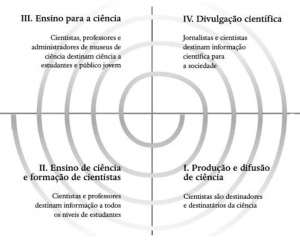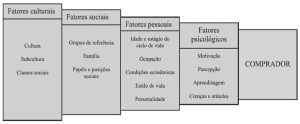REVIEW ARTICLE
ROSA, Lucas Rafael Belém [1]
ROSA, Lucas Rafael Belém. The feelings of a society reflected in cinematic movements. Revista Científica Multidisciplinar Núcleo do Conhecimento. Year 05, Ed. 11, Vol. 21, pp. 144-152. November 2020. ISSN: 2448-0959, Access link: https://www.nucleodoconhecimento.com.br/communication-en/cinematic-movements
SUMMARY
From German expressionism, after the end of the first war, which was based on the view of reality as a collective nightmare, to the new cinema, a Brazilian movement censored by the military coup in the 60s, cinema lived its apex of genuine creativity. For most people, this is an art communally seen as being an entertainment, only. Of course, it’s not a completely erroneous idea. However, this article seeks to demystify, or, perhaps, show, the possibility of cinema as an excellent means of communication, an alternative way of narrating historical events. The objective is that this article is a recorded memory about the importance of cinema in a social sphere, a study that broadens the view of the seventh art as an art beyond the circle of moviegoers. In all, 4 remarkable movements in the seventh art were chosen and mastered, and their main films cited. Therefore, it is seen that not only cinema, but art as a whole, is free, alive and, consequently, adaptable. Free to be anything you want to be and open to debate and discussion.
Keywords: Cinematic Movements, Seventh Art, History.
INTRODUCTION
The transition from cinema as a rising art, denied by intellectuals in the early twentieth century, to a structured art, but corrupted by the estimated profit of the cultural industry, and which easily applies to the concept of Theodor Adorno and Max Horkheimer, is undoubtedly curious. After all, cinema is an art that developed in clubs and had as its main audience underprivileged social groups. This caused films to evolve into something torn between art and industry. Most of the time, they’re both. In addition, there have been several attempts, sometimes a response to the socioeconomic conditions of a country in question, to rebuild, or reinvent cinema as a purely genuine art, or at least in something that approximated it. A period of creative inspiration, resulting in an avant-garde or post-second-world war movement. However, this does not mean that filmmakers have had full success in their artistic goals, especially avant-garde filmmakers.
The loss of meaning due to a linear narrative and without layers is something that directly affects any audiovisual production. Cinema exists on a documentary basis, and it can be surrealist, realistic, expressionist, or perhaps none of it. And it is in this characteristic that arises the problem of a hero who appeases opinions: no idea is so simple that it has no divergences, this turns any story into a simplistic version of reality, as seen in “Battleship Potemkin”, 1926, by Sergei Eisenstein. Or, unfortunately, as seen in most avant-garde cinema, since its main goal was to shock the bourgeoisie.
Let us ignore, however, the Russian avant-garde cinema as political propaganda: revolutions are not given easily. With cinema a documentary basis of reality, manipulation remains a manipulation. But you see: manipulation in cinema is intrinsic when well-intentioned and done in order to convey the desired message.
“Intolerance: Love’s Struggle Throughout the Ages”, 1916, a film by D. W. Griffith, called by many the father of cinema. An example of malicious manipulation. The propaganda of a self-image that arises after an act not only of intolerance, but criminal and immoral. Film made by Griffith shortly after the huge success between the white and racist American installment of “The Birth of a Nation”. Decades of controversy, denounced by Spike Lee in his “BlacKkKlansman”, 2018.
And that’s when we get to the heart of cinema as a means of communication: a tragedy resulting in artistic expressions and political notes through the genius that only art provides. End of a world war, brought to a single country through an unequal treaty. A nightmare-like reality, a pessimistic feeling about the future, German Expressionism.
DEVELOPMENT
The bursting of the first war in 1914 caused European film productions to cease. It was a few years before Germany, even if completely unstructured, returned to creating art. The German government’s incentive to create films was intrinsic, curious at the same time. The question, however, was not to produce, but to produce. Winning countries did not want to participate in the sale and exchange of German art, as well as rejecting the possibility of showing their films in a supposedly enemy country. Again, what to talk about? Perhaps conveying the feelings of society as a whole was the best way to create cinema in times of chaos. In Paul Leni’s vision, we see a man ridiculed and depressed for not being able to stop smiling.
German expressionist films were the modifiers of the prejudiced vision that rich and theater critics of the 1920s had about cinema, while American filmmakers created the image, in an extreme patriarchal era, of what they call a “touchy woman”, who drank, smoked and voted. “A Fool There Was”, 1915, directed by Frank Powell, the adaptation of a poem of the same name, where the “vampire energy” of femininity threatened the capitalism of the evolving Aryan man. An American production that, according to Philip Kemp in his book “All About Cinema – Tudo Sobre Cinema” (2011), contributed unconsciously to the emergence of the Nazi genocide. And we left, then, for 1940, exactly one year after the start of the second war. Chaplin’s sarcastic and surprisingly spoken propaganda. Despite the possibility of seeming an affront, a film in which Hitler apparently saw it several times.
Why is Chaplin’s first spoken film perhaps his most politicized? Why does cinema becomes art during the emergence of works in the midst of hunger and poverty? The answer is clear: the consensus on what art is only becomes universal after being able to prove its value as a means of communication, while encouraging the creative capacity of its creators. However, as observed by Marlene Fortuna in her work called “Art: A Means of Communication and Education In Personality Enhancement – Arte: Um Meio de Comunicação e Educação No Aprimoramento da Personalidade” (1998): “Art is not the faithful representation of reality, even the most figurative, it is always an aesthetic mediation. It presents an originality that unties it from the superficiality of the real.”
From 1940, let’s go back a few years ago. To political chaos and ideological dispute in the United States after the end of the first war. Don’t talk and don’t veicule the freedom of the press and filmmakers being murdered by the American government. “Scarface, The Shame of a Nation – Scarface, A Vergonha de Uma Nação”. Not even the title of the film escaped: the phrase “The Shame of A Nation” was added without the support of the creators of the film. Like it’s the movie’s fault that Al Capone and Bonnie and Clyde were the cover of every newspaper. But by no means does that mean that studios of the time were the good guys, in fact, the production of these films took place due to the apparent American interest in violence. It is curious to see the attempt to hide, or rather, the denial to show, for example, the frequent lynchings of blacks in the country. In “The Brutal and Almost Forgotten History of the Black Lynching Era in america,” Ángel Bermúdez quotes EJI founder Bryan Stevenson: “Say the name of an African-American lynched between 1877 and 1950? Most people don’t know any. Thousands of people have died, but you can’t name one? Why is that? Because we haven’t talked about it.”
Italy of the 1940s, in turn, was more concerned with showing the difficulties experienced by the working class. With the end of the second war, the country was experiencing total political and economic disorder. Among the filmmakers, the idea that the least possible resources should be used: there were no locations, natural lighting and non-professional actors. Names such as Roberto Rossellini and Vittorio De Sica began to draw attention, as well as his best-known films: “Roma Città Aperta” and “Ladri Di Biciclette”. The goal, as it was said, was to film the injustices experienced by the oppressed classes. It was more than cinema, it was a philosophy of life. Or, in the words of Katia Kreutz: “Neorealism was not only a new cinematic style, but a moral and ethical philosophy to free cinema from the confinement of the Hollywood studio system.” It was not only Italian cinema, however, that sought to denounce the chaos caused by the war that began in Germany. Edward Yang, for example, took to screens decades later his “A Brighter Summer Day”, a film that chronicles the emergence of criminal gangs in China after the great war.
The invasion of the Cold War within film productions reached its peak during the 1950s. A possible establishment of communism was the current terror of the American government. Leaders feared the influence of cinema on the people. This time, it was not the fear of the population dreaming of a life of crime, but the fear of ideologically aligning themselves with a left-wing policy. After all, the idea that something could jeopardize the capitalism of the evolving Aryan man was more current than ever. But without the Aryan man. And this time, communism being the real villain. Hollywood was surrounded everywhere, with filmmakers being impeached and denounced. Short investigations, but enough to end the golden age of Hollywood cinema. This chaos, along with the deaths of important influences such as Marilyn Monroe, has ushered in a new phase in American cinema: New Hollywood.
New Hollywood had an almost as pessimistic view of reality as German Expressionism, of course, at a much lower level of impact. Man’s trip to the moon and the advancement of technology, such as the recent invention of television, made the future almost completely impossible to read. There were those who thought of the future being something directly related to the end of humanity, others believed in the total control of rulers over the population. Regardless of belief, filmmakers created an unconditional love for final-twists, which were as unexpected as the future itself. A woman who accepts her newborn son, whose father is something evil. Or, so scientists who travel to the future and find there the end of humanity, but the rise of a civilization of monkeys.
If the dilemma of American cinema was the unpredictability of the future, Brazilian national cinema, however, cared about the present. The military coup almost resembled ideological persecution stouts in Hollywood years earlier. The censored denunciation of “Goat Marked To Die – Cabra Marcado Para Morrer”, considered by many as the best national documentary, is a sad account of the fragility of freedom of expression. A wave of creativity started in the early 1960s, the movement known as Cinema Novo being abruptly disrupted by anti-democracy. However, we are talking about a time when national cinema was being widely recognized at major festivals around the world. “Dry Lives – Vidas Secas””, nominated for the Palme d’Or at the Cannes film festival, for example. It was obvious that there was an obligation of the military not to completely censor Brazilian cinema, but still with censorship. A few years after the military coup, filmmakers, with their mouths shut and their hands tied, felt obliged to create complaints in a useful way. The very title of the films made during and after the coup delivered the absurdity that happened in Brazil: “He killed the Family and went to the Cinema – Matou a Família e foi ao Cinema”.
Some names, such as Steven Spielberg, have hitherto put an end to this emergence of revolutionary movements. The 1980s were dominated by pop culture, from the second British musical invasion to low-budget trash films. A world far from perfection, but a time when filmmakers could finally breathe. In Brazil, the military coup was close to declaring its end after so much damage. However, Brazilian national cinema continued to chart the course of a politicized cinema. From “The Year My Parents Went On Vacation – O Ano em que Meus Pais Saíram de Férias”, released in 2006 and which rescues the memory of the harsh time of censorship, to the recent “Bacurau”, which gained international notoriety such as “Dry Lives” in its debut season.
As it was said, a world far from perfection, and thus it was not only the Brazilian filmmakers who continued to produce films of resistance. On a global stage, a director from Spain drew attention: Pedro Almodóvar. In her debut film, we see a married woman going against a lesbian relationship because her husband doesn’t satisfy her. This era is and is one of several issues raised not only in film, but in art as a whole: the rights of the LGBT community, or, as it was called at the time, LGBT. “Paris Is Burning,” 1990, a documentary directed by Jennie Livingston that chronicles the daily lives of gays and transsexuals in New York 1980: “I am what I am, I am my own special creation.” It’s been decades of struggle for basic rights. Jennie Livingston’s documentary has never been more current: in 2019, the law of criminalization of homophobia came to the fore.
We then have almodóvar’s perspective through a fair militancy, which not only concerns LGBT’s. A director who grew up based on the female figure as an example of strength. The female protagonism in Almodóvar’s films is always directly related to the struggle for equal rights. A progressive director with progressive films. Like the revolutionary ideas of the film movements cited.
CONCLUSION
It is not an obligation for the seventh art to take a posture of politicized art. Art is free, just as Sebastião Salgado photographs injustices, Monet painted landscapes. Certainly, however, this did not prevent cinema, at different times in history, from assuming a position as a spokesperson for society, denouncing injustices and transmitting mutual emotions.
It is impossible to predict whether there will be another time when filmmakers will be taken over by an uncontrollable will to create. Perhaps, the denunciations of the modern world no longer require a wave of critical films, which does not mean that they should not be made, it does not mean, also, that cinema is no longer a means of resistance. After all, the Black Lives Matter movement, for example, makes both “BlacKkKlansman” (2018) and “To Kill a Mockingbird” (1962) extremely current.
REFERENCES
A BRIGHTER SUMMER DAY. Direção: Edward Yang. Produção de Yu Wei-yen. Local: Taiwan. Yang & His Gang Filmmakers, 1991.
A FOOL THERE WAS. Direção: Frank Powell. Produção de William Fox. Local: Estados Unidos. Box Office Attractions Company, 1915.
BACURAU. Direção: Kleber Mendonça Filho. Produção de Emilie Lesclaux. Local: Brasil. SBS Productions, 2019.
BATTLESHIP POTEMKIN. Direção: Serguei Eisenstein. Produção de Jacob Bliokh. Local: Rússia. Mosfilm, 1925.
BERMÚDEZ, Ángel. A História Brutal e Quase Esquecida da Era de Linchamentos de Negros nos EUA. BBC Mundo, 2018. Disponível em: bbc.com/portuguese/internacional-43915363. Acesso em: 24 de setembro de 2020.
BLACKKKLANSMAN. Direção: Spike Lee. Produção de Jason Blum. Local: Estados Unidos. Universal Studios, 2018.
BONNIE AND CLYDE. Direção: Arthur Penn. Produção de Warren Beatty. Local: Estados Unidos. Warner Bros.-Seven Arts, 1967.
CABRA MARCADO PARA MORRER. Direção: Eduardo Coutinho. Produção de Eduardo Coutinho. Local: Brasil. Gaumont do Brasil, 1984.
CINEMA NA DITADURA. Memórias da Ditadura. Disponível em: memoriasdaditadura.org.br/cinema. Acesso em: 24 de setembro de 2020.
FORTUNA, Marlene. Arte: Um Meio de Comunicação e Educação No Aprimoramento da Personalidade. Revista LÍBERO, 1998. Disponível em: http://www.portcom.intercom.org.br/pdfs/097ef92e6dd2c4858e9d24e2640e5872.pdf. Acesso em: 24 de setembro de 2020.
INTOLERANCE: LOVE’S STRUGGLE THROUGHOUT THE AGES. Direção: D. W. Griffith. Produção de D. W. Griffith. Local: Estados Unidos. Triangle Distributing Corporation, 1916.
KEMP, Philip. Tudo Sobre Cinema. Rio de Janeiro: Sextante, 2011, 576 páginas.
KREUTZ, Katia. Neorrealismo Italiano. Academia Internacional de Cinema, 2018. Disponível em: aicinema.com.br/neorrealismo-italiano. Acesso em: 24 de setembro de 2020.
LADRI DI BICICLETTE. Direção: Vittorio De Sica. Produção de Ercole Graziadei. Local: Itália. Produzioni De Sica, 1948.
MATOU A FAMÍLIA E FOI AO CINEMA. Direção: Júlio Bressane. Produção de Júlio Bressane. Local: Brasil. Embrafilme, 1969.
O ANO EM QUE MEUS PAIS SAÍRAM DE FÉRIAS. Direção: Cao Hamburger. Produção de Cao Hamburger. Local: Brasil. Gullane Filmes, 2006.
PARIS IS BURNING. Direção: Jennie Livingston. Produção de Jennie Livingston. Local: Estados Unidos. Academy Entertainment Off White Productions, 1990.
PEPI, LUCI Y BOM. Direção: Pedro Almodóvar. Produção de Pepón Coromina. Local: Espanha. Fígaro Films, 1980.
PEREIRA, Maria Eduarda; NEVES, Helen. Criminalização da LGBTfobia: Uma Problematização Necessária. Revista Âmbito Jurídico, 2019. Disponível em: https://ambitojuridico.com.br/cadernos/direito-constitucional/criminalizacao-da-lgbtfobia-uma-problematizacao-necessaria/#_ftn2. Acesso em: 24 de setembro de 2020.
PLANET OF THE APES. Direção: Franklin J. Schaffner. Produção de Arthur P. Jacobs. Local: Estados Unidos. APJAC Productions, 1968.
ROMA CITTÀ APERTA. Direção: Roberto Rossellini. Produção de Giuseppe Amato. Local: Itália. Minerva Film, 1945.
ROSEMARY’S BABY. Direção: Roman Polanski. Produção de William Castle. Local: Estados Unidos. William Castle Enterprises, 1968.
SCARFACE. Direção: Howard Hawks. Produção de Howard Hughes. Local: Estados Unidos. The Caddo Company, 1932.
THE BIRTH OF A NATION. Direção: D. W. Griffith. Produção de D. W. Griffith. Local: Estados Unidos. David W. Griffith Corp, 1915.
THE GREAT DICTATOR. Direção: Charlie Chaplin. Produção de Charlie Chaplin. Local: Estados Unidos. Charles Chaplin Film Corporation, 1940.
THE MAN WHO LAUGHS. Direção: Paul Leni. Produção de Paul Kohner. Local: Estados Unidos. Universal Studios, 1928.
TO KILL A MOCKINGBIRD. Direção: Robert Mulligan. Produção de Alan J. Pakula. Local: Estados Unidos. Universal International Pictures, 1962.
VIDAS SECAS. Direção: Nelson Pereira dos Santos. Produção de Luiz Carlos Barreto. Local: Brasil. Produções Cinematográficas Herbert Richers, 1963.
[1] Graduating in Journalism.
Submitted: October, 2020.
Approved: November, 2020.






